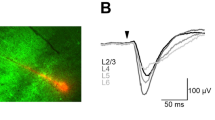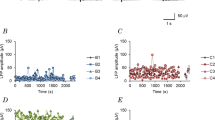Abstract
The primary sensory feature represented within the rodent barrel cortex is the velocity with which a whisker has been deflected. Whisker deflection velocity is encoded within the thalamus via population synchrony (higher deflection velocities entail greater synchrony among the corresponding thalamic population). Thalamic (TC) cells project to regular spiking (RS) cells within the barrel cortex, as well as to inhibitory cortical fast-spiking (FS) neurons, which in turn project to RS cells. Thus, TC spikes result in EPSPs followed, with a small time lag, by IPSPs within an RS cell, and hence the RS cell decodes TC population synchrony by employing a phase-delayed inhibition synchrony detection scheme. As whisker deflection velocity is increased, the probability that an RS cell spikes rises, while jitter in the timing of RS cell spikes remains constant. Furthermore, repeated whisker deflections with fixed velocity lead to system adaptation – TC →RS, TC →FS, and FS →RS synapses all weaken substantially, leading to a smaller probability of spiking of the RS cell and increased jitter in the timing of RS cell spikes. Interestingly, RS cell activity is better able to distinguish among different whisker deflection velocities after adaptation. In this work, we construct a biophysical model of a basic ‘building block’ of barrel cortex – the feedforward circuit consisting of TC cells, FS cells, and a single RS cell – and we examine the ability of the purely feedforward circuit to explain the experimental data on RS cell spiking probability, jitter, adaptation, and deflection velocity discrimination. Moreover, we study the contribution of the phase-delayed inhibition network structure to the ability of an RS cell to decode whisker deflection velocity encoded via TC population synchrony.










Similar content being viewed by others
References
Adibi, M., Clifford, C., Arabzadeh, E. (2013a). Informational basis of sensory adaptation: entropy and single-spike efficiency in rat barrel cortex. The Journal of Neuroscience, 33(37), 14921–14926.
Adibi, M., McDonald, J., Clifford, C., Arabzadeh, E. (2013b). Adaptation improves neural coding efficiency despite increasing correlations in variability. The Journal of Neuroscience, 33(5), 2108–2120.
Benowitz, L.I., & Karten, H.J. (2004). Organization of the tectofugal visual pathway in the pigeon: A retrograde transport study. The Journal of Comparative Neurology, 167(4), 503–520.
Benshalom, G., & White, E. (1986). Quantification of thalamocortical synapses with spiny stellate neurons in layer iv of mouse somatosensory cortex. Journal of Computational Neuroscience, 253(3), 303–314.
Blitz, D.M., & Regehr, W.G. (2005). Timing and specificity of feed-forward inhibition within the LGN. Neuron, 45(6), 917–928.
Bruno, R. (2011). Synchrony in sensation. Current Opinion in Neurobiology, 21(5), 701–708.
Bruno, R., & Sakmann, B. (2006). Cortex is driven by weak but synchronously active thalamocortical synapses. Science, 312(5780), 1622–1627.
Bruno, R., & Simons, D. (2002). Feedforward mechanisms of excitatory and inhibitory cortical receptive fields. The Journal of Neuroscience, 22(24), 10966–10975.
Cruikshank, S., Lewis, T., Connors, B. (2007). Synaptic basis for intense thalamocortical activation of feedforward inhibitory cells in neocortex. Nature Neuroscience, 10, 462–468.
Deng, C., & Rogers, L.J. (1998). Organisation of the tectorotundal and SP/IPS-rotundal projections in the chick. The Journal of Comparative Neurology, 394(2), 171–185.
Eckhorn, R. (1994). Oscillatory and non-oscillatory synchronizations in the visual cortex and their possible roles in associations of visual features. Progress in Brain Research, 102, 405–426.
Fricker, D., & Miles, R. (2000). EPSP amplification and the precision of spike timing in hippocampal neurons. Neuron, 28(2), 559–569.
Friedrich, R., Habermann, C., Laurent, G. (2004). Multiplexing using synchrony in the zebrafish olfactory bulb. Nature Neuroscience, 7, 862–871.
Gabernet, L., Jadhav, S., Feldman, D., Carandini, M., Scanzianiemail, M. (2005). Somatosensory integration controlled by dynamic thalamocortical feed-forward inhibition. Neuron, 48(2), 315–327.
Gray, C. (1994). Synchronous oscillations in neuronal systems: mechanisms and functions. Journal of Computational Neuroscience, 1, 11–38.
Guillery, R. (1967). Patterns of fiber degeneration in the dorsal lateral geniculate nucleus of the cat following lesions in the visual cortex. Journal of Computational Neuroscience, 130(3), 197–221.
Jortner, R.A., Farivar, S.S., Laurent, G. (2007). A simple connectivity scheme for sparse coding in an olfactory system. The Journal of Neuroscience, 27(7), 1659–1669.
Joshi, B., & Patel, M. (2013). Encoding with synchrony: Phase-delayed inhibition allows for reliable and specific stimulus detection. Journal of Theoretical Biology, 328, 26–32.
Kyriazi, H., & Simons, D. (1993). Thalamocortical response transformations in simulated whisker barrels. Journal of Neuroscience, 13(4), 1601–1615.
Laurent, G., & Davidowitz, H. (1994). Encoding of olfactory information with oscillating neural assemblies. Science, 265, 1872–1875.
Leitch, B., Laurent, G., et al. (1996). GABAergic synapses in the antennal lobe and mushroom body of the locust olfactory system. The Journal of Comparative Neurology, 372(4), 487–514.
Liu, X., Honda, C., Jones, E. (1995). Distribution of four types of synapse on physiologically identified relay neurons in the ventral posterior thalamic nucleus of the cat. Journal of Computational Neuroscience, 352(1), 69–91.
Ly, C., Middleton, J., Doiron, B. (2012). Cellular and circuit mechanisms maintain low spike co-variability and enhance population coding in somatosensory cortex. Frontiers in Computational Neuroscience, 6(7).
Marthy, V., & Fetz, E. (1992). Coherent 25- to 35-hz oscillations in the sensorimotor cortex of awake behaving monkeys. Proceedings of the National Academy of Sciences of the United States of America, 89, 5670–5674.
Middleton, J., Omar, C., Doiron, B., Simons, D. (2012). Neural correlation is stimulus modulated by feedforward inhibitory circuitry. The Journal of Neuroscience, 32(2), 506–518.
Mittmann, W., Koch, U., Häusser, M. (2005). Feed-forward inhibition shapes the spike output of cerebellar purkinje cells. The Journal of Physiology, 563(2), 369–378.
Patel, M., & Joshi, B. (2013). Decoding synchronized oscillations within the brain: phase-delayed inhibition provides a robust mechanism for creating a sharp synchrony filter. Journal of Theoretical Biology, 334, 13–25.
Patel, M., Rangan, A V, Cai, D. (2009). A large-scale model of the locust antennal lobe. Journal of Computational Neuroscience, 27(3), 553–567.
Patel, M., Rangan, A.V., Cai, D. (2013). Coding of odors by temporal binding within a model network of the locust antennal lobe. Frontiers in Computational Neuroscience, 7(50), 1–18.
Patel, M., & Reed, M. (2013). Stimulus encoding within the barn owl optic tectum using gamma oscillations vs. spike rate: A modeling approach. Network: Computation in Neural Systems, 24(2), 52–74.
Perez-Orive, J., Mazor, O., Turner, G.C., Cassenaer, S., Wilson, R.I., Laurent, G. (2002). Oscillations and sparsening of odor representations in the mushroom body. Science, 297(5580), 359–365.
Pesavento, M., & Pinto, D. (2012). Network and neuronal membrane properties in hybrid networks reciprocally regulate selectivity to rapid thalamocortical inputs. Journal of Neurophysiology, 108(9), 2452–2472.
Pesavento, M., Rittenhouse, C., Pinto, D. (2010). Response sensitivity of barrel neuron subpopulations to simulated thalamic input. Journal of Neurophysiology, 103(6), 3001–3016.
Petersen, C. (2007). The functional organization of the barrel cortex. Neuron, 56(2), 339–355.
Pinto, D., Brumberg, J., Simons, D. (2000). Circuit dynamics and coding strategies in rodent somatosensory cortex. Journal of Neurophysiology, 83(3), 1158–1166.
Pinto, D., Brumberg, J., Simons, D., Ermentrout, G. (1996). A quantitative population model of whisker barrels: re-examining the wilson-cowan equations. Journal of Computational Neuroscience, 3(3), 247–264.
Pinto, D., Hartings, J., Brumberg, J., Simons, D. (2003). Cortical damping: Analysis of thalamocortical response transformations in rodent barrel cortex. Cerebral Cortex, 13(1), 33–44.
Pouille, F., & Scanziani, M. (2001). Enforcement of temporal fidelity in pyramidal cells by somatic feed-forward inhibition. Science, 293(5532), 1159–1163.
Sridharan, D., Boahen, K., Knudsen, E.I. (2011). Space coding by gamma oscillations in the barn owl optic tectum. Journal of Neurophysiology, 105(5), 2005–2017.
Sun, Q., Huguenard, J., Prince, D (2006). Barrel cortex microcircuits: Thalamocortical feedforward inhibition in spiny stellate cells is mediated by a small number of fast-spiking interneurons. Journal Neuroscience, 26(4), 1219–1230.
Tao, L., Shelley, M., McLaughlin, D., Shapley, R. (2004). An egalitarian network model for the emergence of simple and complex cells in visual cortex. Proceedings of the National Academy of Sciences of the United States of America, 101(1), 366.
Temereanca, S., Brown, E., Simons, D. (2008). Rapid changes in thalamic firing synchrony during repetitive whisker stimulation. The Journal of Neuroscience, 28(44), 11153–11164.
Temereanca, S., & Simons, D. (2004). Functional topography of corticothalamic feedback enhances thalamic spatial response tuning in the somatosensory whisker/barrel system. Neuron, 41, 639–651.
Wang, Q., Webber, R., Stanley, G. (2010). Thalamic synchrony and the adaptive gating of information flow to cortex. Nature Neuroscience, 13, 1534–1541.
Wehr, M., & Zador, A.M. (2003). Balanced inhibition underlies tuning and sharpens spike timing in auditory cortex. Nature, 426(6965), 442–446.
Wilent, W., & Contreras, D. (2005). Dynamics of excitation and inhibition underlying stimulus selectivity in rat somatosensory cortex. Nature Neuroscience, 8(10), 1364–1370.
Acknowledgments
Runjing Liu and Mainak Patel were partially supported by a National Science Foundation grant (DMS-0943760).
Conflict of interest
The authors declare that they have no conflict of interest.
Author information
Authors and Affiliations
Corresponding author
Additional information
Action Editor: David Golomb
Rights and permissions
About this article
Cite this article
Liu, R., Patel, M. & Joshi, B. Encoding whisker deflection velocity within the rodent barrel cortex using phase-delayed inhibition. J Comput Neurosci 37, 387–401 (2014). https://doi.org/10.1007/s10827-014-0535-3
Received:
Revised:
Accepted:
Published:
Issue Date:
DOI: https://doi.org/10.1007/s10827-014-0535-3




